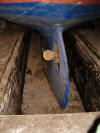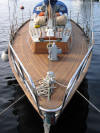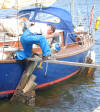Before
Keel in pit
We checked into the Kalev Yacht Club near Tallinn, which the Baltic Pilot recommended for it's on-site shipwrights and facilities. Olev Roosma, the club Commodore, introduced us to woodwork and steel specialists and we discussed ideas for putting Philomelle's decks in order. Although many people in the Baltic states speak good English, much of our discussion consisted of sign language and sketching. The yard undertook to look after the boat until the following Summer, and we flew home to await a work proposal by email.
After a few weeks we had come to an agreement with Erik Margijev, who runs a stainless steel fabrication business and supplies marine fittings. The old teak and plywood was to be stripped away, and the existing steel structure would be overlaid with 2mm stainless steel wherever it was in contact with wood. New ply and teak would be laid to the original design. Existing galvanised fittings, including pushpit and pulpit, would be replaced with custom-made stainless.
Preparation
Scupper drain
Parts of the upper hull and scupper were later cut away and new (stainless) steel fixed in place. After cleaning, the steel was painted with zinc-rich paint. Back at home I waited for news, and in January Erik emailed the first photos of progress. Work through the winter progressed slowly (it seemed) and I was impatient for news. Erik speaks little English (and regrettably I speak no Estonian or Russian). It was a frustrating time!

Stainless lining under cabin side

Scuppers
Plank join
The first plank of the teak deck was laid in late April. The new pushpit also appeared on a photo at this time (to the usual Baltic design with a low step to allow stepping ashore over the bow). In early May I made another visit to Tallinn, spending a week in the workshop. The deck was mostly laid when I arrived, and Eix was trimming the surplus silkaflex and finishing with an orbital sander. I spent the week fitting a new wheel-pilot, replacing seals in the heads, new greaser for the rudder bearing, more wiring, cleaning, painting and varnishing. We agreed plans for the new stanchions, with a gate near the shrouds, and a swim ladder.
First teak laid
Aft deck
Launched
Back at home we planned our voyage home via Helsinki and Stockholm. The boat should soon be back in the water. The time went by and communication with Estonia went dead. In June I emailed the local Cruising Association representative who found that Erik's email was not working, and the boat was still in the workshop with lots of work to finish. A fortnight before our departure, Erik announced it would e a week late. I replied that I would have to reduce the agreed price for each day lost, but would pay extra if he finished on time.
Mon 12th July - not an auspicious start. I lost my wallet at
the airport, and missed my flight. I eventually arrived in Estonia 2 days
late, with no local currency and no plastic! Arrived at Kalev YC at Pirita
to find Philomelle swarming with carpenters and the cabin heaped with most
of our stuff, and everything covered in dust from the renovation work. The
new decks were looking beautiful, the bronzework polished to a shine, and
new stainless steel scuppers and stanchions looking splendid. The iron
fittings had been galvanised too, and the winch coated with epoxy paint.
Still lots to do however. The boat was in the water with the mast up, but
the rig wanted some work and I had to clean and fit out the interior before
Justine, Naomi and James arrived next day. Plus the decks and cabin needed
teak oil, there was wiring to complete, engine to check, provisions for
several weeks to procure, painting, and several other tasks to do before we
could sail.
Somehow Friday evening came and we were ready – apart from a few things we
could do ‘as we went along’. Justine, Naomi and James had arrived on
Wednesday night, and pitched in to help. With new mainsail fitted, we set
off in a strong breeze for a trial sail around the bay. Early next day we
made final rig adjustments, wired bottle screws, stowed the bicycle, motored
round to the Customs pontoon at 08:30 and set off for Helsinki.
No shoes please
Kiejo
Hauled out
Lessons learned? Having a written specification with proper drawings would have been a good plan. I also needed to keep in touch better, perhaps via the Cruising Association HLR or another agent who spoke good English. Are we pleased with the work? Well, the workmanship was mostly excellent and the materials good quality. The finish was very rushed though, resulting in some leaks, and I fear we'll never really be free of them. However the decks and cabin sides do look rather splendid.
As an epilogue, we had one more boatyard visit in Helsinki before we could continue our journey - on our sea trial we found that both depth transducers were defunct, and we had to have her hauled out to replace them. The boatyard of Keijo Saarinen on the island of Suomelina belongs to another age. A trolley runs on rails up a long incline from the water, and boats are hauled on wooden cradles across tree trunk rails on each side. We selected the largest available cradle for Philomelle, winched it onto the trolley, and let it down into the sea. I motored over the cradle, and Kiejo himself directed all operations, placing wedges. Philomelle emerged with a slight list, but secure, and I spent some happy hours cutting out the old transducers and fitting new ones, with a little help and loan of tools from the yard. We managed to finish and slip back into the water before the yard closed for the day.










